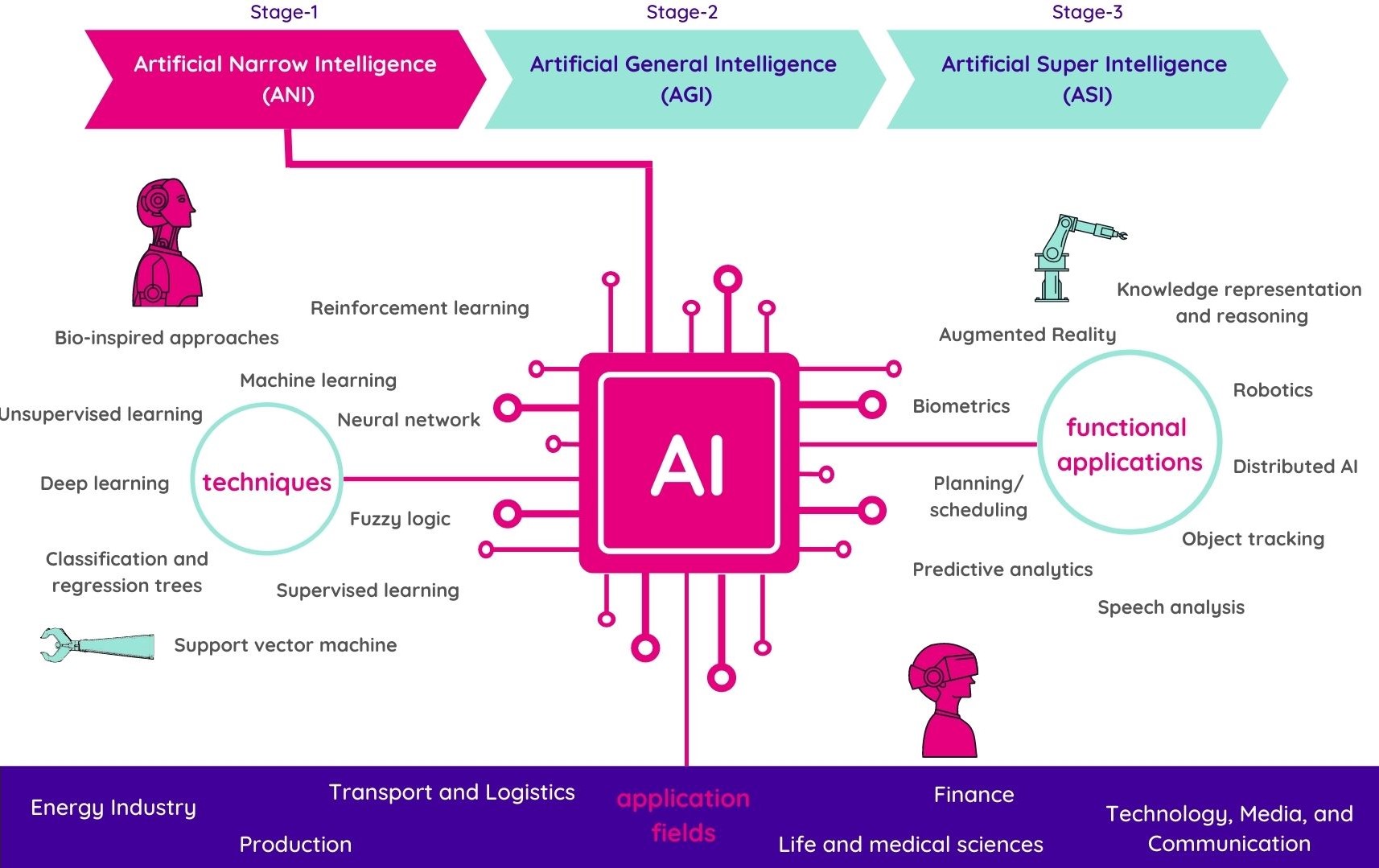
AI Stages 💡 From Artificial Narrow Intelligence to Artificial Superintelligence 🚀
23 June, 2023
Welcome to an exciting exploration of the fascinating world of Artificial Intelligence (AI) 🌟. In this blog post, we will delve into the different stages of AI, the techniques used to implement AI functions, and the diverse applications of AI across various fields.
🌟 AI Stages 🌟
Artificial Narrow Intelligence (ANI) 💻 Also known as weak AI, ANI specializes in specific tasks and excels in performing them. From Google's search algorithms to smartphone apps and drone robots, we encounter weak AI in our everyday lives. Currently, ANI is the only existing form of AI.
Artificial General Intelligence (AGI) 🧠 Referred to as strong AI, AGI represents a machine that possesses intelligence on par with humans. It is capable of competing with humans across various domains, including education. Although achieving AGI is a significant challenge due to the complexity of the human brain, experts predict its emergence by around 2060, albeit with some uncertainty.
Artificial Superintelligence (ASI) 🌌 ASI surpasses human intelligence and possesses self-improving capabilities. While ASI remains a concept that is likely hundreds of years away from development, ethical debates have already emerged regarding the potential risks associated with pursuing AI without adequate control.
n

🔬 AI Techniques 🔬
Machine Learning (ML) 🤖 ML is a subfield of AI that focuses on enabling software programs to gain insights from data. By recognizing patterns and regularities within datasets, ML algorithms develop solutions and make predictions.
Classification and Regression Trees 🌳 These algorithms represent decision-making processes as a series of rules in a tree structure. They are used to predict values based on attributes and provide discrete outcomes.
Fuzzy Logic 🌈 Fuzzy logic utilizes multivalued logic to make decisions, considering intensity (degree) of truth between 0 and 1. It differs from binary logic and allows for more nuanced decision-making.
Neural Networks 🧠 Inspired by the human brain, neural networks consist of interconnected artificial neurons organized in layers. These networks can tackle complex tasks by passing information through successive layers of functions.
Deep Learning 🧪 A subarea of machine learning, deep learning involves training neural networks with large amounts of data. The system learns from the data and makes connections to generate intelligent responses. Increasing the number of layers in a neural network enhances its performance.
Bio-inspired Approaches 🌱 These algorithms draw inspiration from various biological systems, going beyond mimicking the human brain. They enable autonomous self-organization and adaptive decision-making, leveraging concepts like swarm intelligence.
Reinforcement Learning 🎯 This subset of machine learning employs a reward and punishment system for an agent to learn how to select actions in an environment. The goal is to maximize rewards over time.
Supervised Learning 📚 A widely adopted approach, supervised learning involves training AI systems with labeled data to categorize new, unseen data into predefined categories. It relies on a predefined set of classes.
Support Vector Machine 👥 This supervised learning algorithm analyzes labeled data, identifies challenging data points, and classifies unseen data points by separating different groups.
Unsupervised Learning 🧩 Unlike supervised learning, unsupervised learning analyzes unlabeled data to discover hidden patterns or commonalities. It classifies data by identifying and creating groups or labels.
💼 AI Functional Applications 💼
AI functional applications encompass a wide range of operations performed by AI techniques, independent of the application field. Some notable examples include:
Augmented Reality. Enhancing human perception by integrating computer-generated elements into the real world, such as texts, images, and animations.
Biometrics. Utilizing measurements and analysis of biological characteristics for identification or verification purposes, like fingerprint or face recognition.
Knowledge Representation and Reasoning. Representing real-world information for machines to understand and solve complex problems, enabling intelligent behavior.
Conclusion
In summary, Artificial Intelligence (AI) is driving significant transformations across industries, presenting immense business opportunities. With applications ranging from Augmented Reality to Biometrics and Knowledge Representation, AI empowers businesses to enhance customer experiences, optimize operations, and gain a competitive edge.
By harnessing powerful AI techniques like Machine Learning, Neural Networks, and Bio-inspired Approaches, businesses can make intelligent decisions, solve complex problems, and adapt to changing market dynamics. The potential for AI to revolutionize workflows, automate tasks, and enable data-driven insights is truly remarkable.
As the business landscape evolves, staying at the forefront of AI advancements is crucial for organizations seeking growth and innovation. Embracing AI technologies and leveraging their potential can unlock new levels of productivity, efficiency, and customer satisfaction.
Join the AI revolution and position your business for success in the digital age. Explore the possibilities, collaborate with industry experts, and embrace AI-driven solutions to drive your business forward.